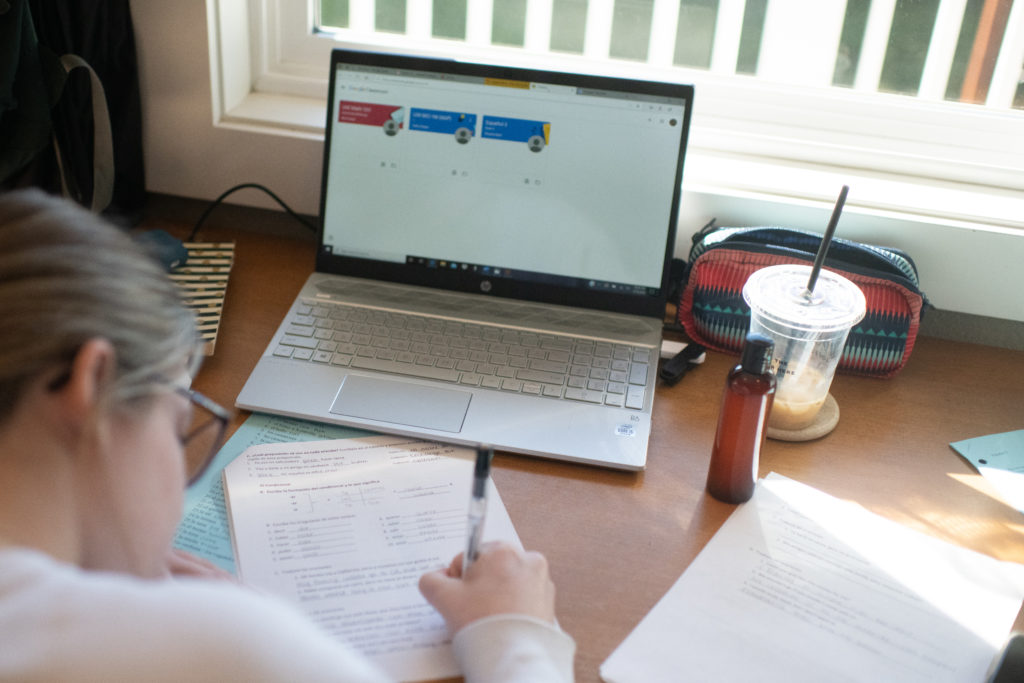To all my teacher friends who are moving their classes online. Here, in no particular order, are some of my top tips for online teaching (these will mostly apply to high school teachers, but may also have some use for grade school.) First, take a deep breath. This is going to be different and sometimes difficult, but you got this!
1. Planning: Think by Week, not by Day. When I moved from the online to the classroom, the most significant shift that I noticed was the way that my planning had to shift. Moving from the classroom to online is no different. Instead of thinking about what you need to do each day or planning in-class lectures and activities, think about planning week by week. What do you want your students to know/learn/do by the end of the week? What do you need to do to facilitate that goal [short lecture, link to a video, online activity, reading assignment, discussion, etc.]? How can you create a few touchpoints during the week to see how the students are progressing towards the end of the week goal? Planning weeks rather than days will also be helpful for those of us whose schools have decided to do mostly asynchronous learning (students can log-in at different times). When I plan for online, I usually try to determine what I want students to know or be able to do by the end of the week and then plan backwards so that I can figure out what types of readings, lectures, videos, etc. will help me fulfil the learning outcome/s in the best way possible.
2. Mentor/Coach/Facilitator: You are all of these things already but moving online really accentuates these rolls—especially the role of facilitator. You will miss the way that you get to interact with the students in the classroom. But you will get to facilitate their learning in a whole new way. One of the benefits of online learning is that students can (although they will not always) take ownership of their own learning in a whole new way. Your role is to facilitate their learning and coach and mentor them along the way. As you do, think about some creative ways to get students engaged and finding materials on their own. How can they become active participants in the learning process? It can be easy to just try to duplicate what you do in the classroom and try to deliver the same content but just in an online format (i.e. recording the same lectures that you would have done in class and posting them online). However, are there assignments that you could create that get students searching around the web and providing resources. Are there questions that you could pose at the beginning of the week that students grapple with together? Could you have students come up with a list of questions or topics they really want to explore together? (some of these questions work much better for the humanities… I know! I will readily admit that I am no master at teaching math or science online or in person).
3. Communication: You will need to communicate. Communicate again. And communicate again. And even then, you will get e-mails. Think about how many times you repeat things in a classroom and the tricks that you have learned to make sure that your students are listening/paying attention and grasp what you are saying. Most of these tools do not translate online easily. This means that a lot of the tools that you have in your toolkit are not going to work, and you will need to learn some new ones to communicate to your students. However, do not despair. Learning Management Systems (LMS) are set up to help you communicate. And I find that creating a few avenues for students to hear the same information can be really helpful. I usually try to have everything in written format on the LMS as well as on the document they will need to use to complete the assignment. I have also created video or written announcements at the beginning of the week to review what we did the previous week and give a preview of what’s coming up. Quizzes, although not beloved by students, are another good way to make sure that students have understood directions for a major assignment. There are also some great platforms that allow students to interact with a video that you have created (but don’t go for this as your first option: see #4)
A note about E-mails: One of the realities of online learning is that you will get a lot of e-mails. When I first started teaching online, this freaked me out. I thought I was really unclear. However, I soon realized that in the online environment e-mails are the way you “raise your hand” to ask a question. When I hand out an assignment in my classroom and four hands go up to ask for clarification, I don’t bat an eye. When you assign something online, the same thing can happen. But rather than it being a hand raised, it is an e-mail.
A note about video communication: As we all get used to teaching online and start to search for resources, know that it is really important for your students to see you from time to time. This does not mean you need to go out and create some highly produced youtube video, but it is important for them to see your face. Find videos for lectures and such (there are some great ones out there), but really do try to find a way to touch base with your students so that they see your face!
4. Technology: Start simple. Mastering one or two things is better than tinkering with many. The amount of online companies offering free software right now is truly amazing. AND OVERWHELMING! Each platform or program offers endless educational possibilities, but they also require time and effort to figure out. That is time for both you and your students. Find what you need to get your objectives done. If you have mastered your LMS and feel confident in a few other things, start to look around for new ways to fulfil your learning objectives for the week. But, don’t think that having 45 apps is the only way that you can successfully deliver content. You will have time (and it looks like quite a bit of it) to learn the new apps and start trying things. But don’t start that way!
5. Discussions: Keep the groups small & ask questions that spark discussion (*do not, I repeat, do not ask students to respond to a closed-ended question on content.). Asynchronous online discussion is hard! But it can be good. Think about the fact that every student will participate. The shy students or students who do not participate much will have a voice in the online format. This is really exciting! However, there are some downsides. Discussions will not feel as dynamic or as organic. This means coming up with a good discussion prompt or environment is essential. Great questions lead to great discussions. But, do know that they will not always feel as natural, and your students are going to likely engage in them in a transactional way (i.e. they will check out once they have posted the requisite number of posts). However, that does not mean that they are not engaging or learning. It is just different. You can also use discussion boards to facilitate other forms of discussion as well like having someone play devil’s advocate or a jig-saw type discussion. There are some great protocols online for creating online discussions, I would suggest googling them to see what you can find!
A note on video chats: Try, if you can, to get some live engagement with students during this time. This will be challenging, but it could be really rich (especially since many of us will be missing social interaction). Meet with groups of students over video conferencing. Have groups of students meet together and then write a short report of their meeting. Just because most of us are moving to doing most things asynchronous does not mean that we can’t have some synchronous elements built-in!
Finally, and importantly. Be gracious with yourself and with your students. This is a difficult situation for most of us. Many of our students are dealing with sadness, anxiety, and uncertainty and they are also new to this. A lot of our high school students will now be tasked with taking care of siblings, and many of our students will have to share the family computer with siblings. We are new to this too. There will be some failures. That’s ok. There will be some major successes too. There will be frustration. That’s ok. There will be some amazing moments as well.
This is a recent Facebook post written by Dr. Gayle Doornbos and used with her permission.



